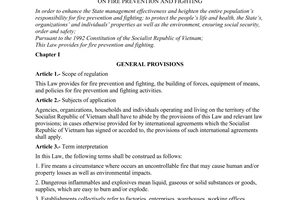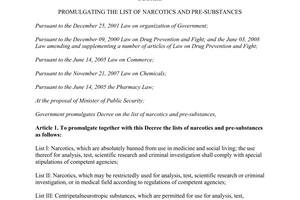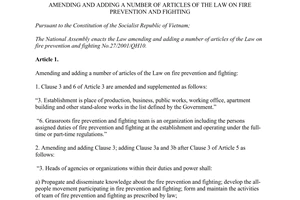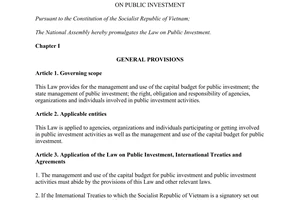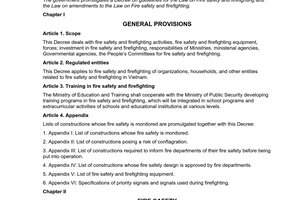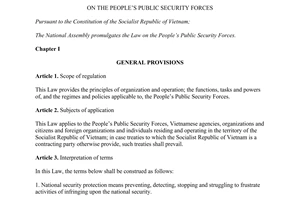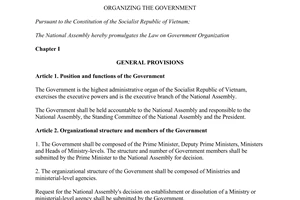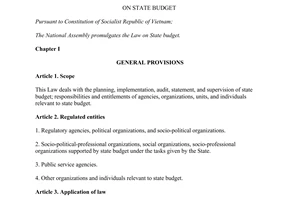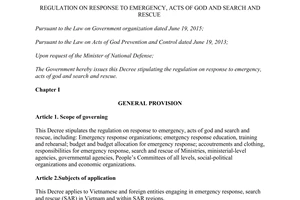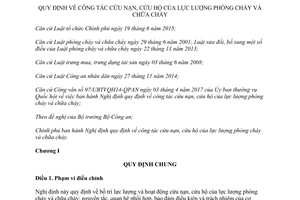Nội dung toàn văn Decree 83/2017/ND-CP regulation on rescue operations by fire deparments
|
GOVERNMENT |
SOCIALIST
REPUBLIC OF VIETNAM |
|
No. 83/2017/ND-CP |
Hanoi, July 18, 2017 |
DECREE
REGULATION ON RESCUE OPERATIONS BY FIRE DEPARMENTS
Pursuant to the Law on Government organization dated June 19, 2015;
Pursuant to the Law on Fire safety and firefighting dated June 29, 2001; the Law on amendments to the Law on Fire safety and firefighting dated November 22, 2013;
Pursuant to the Law on Compulsory Purchase and Requisition of Property dated June 03, 2008;
Pursuant to the Law on the People’s Public Security Forces dated November 27, 2014;
Pursuant to the Official Dispatch No. 97/UBTVQH14-QPAN dated April 03, 2017 of the Standing Committee of National Assembly on promulgating the Decree on rescue operations by fire departments;
At the request of the Minister of Public Security;
The Government promulgates the regulation on rescue operations by fire departments.
Chapter I
GENERAL PROVISIONS
Article 1. Scope
This Decree regulates the arrangement of forces and the rescue operations by fire departments; principles, relationship of cooperation and assurance of requirements and responsibilities of relevant organizations and individuals.
Article 2. Regulated entities
This Decree applies to agencies, organizations, households and individuals currently operating or residing in the Vietnam territory; in case treaties to which the Socialist Republic of Vietnam is a contracting party otherwise provide, such treaties shall prevail.
Article 3. Definitions
In this Decree, these terms are construed as follows:
1. Rescue” refers to an act of saving victims, vehicles and properties from any danger caused by emergencies or emergency situations, including: Detect, locate, open ways to access to the victims, vehicles and properties in danger, arrange vehicles, tools and rescue forces; identify, prevent and eliminate factors threatening the safety of vehicles, properties, lives and health of the victims and the relief and rescue forces; remove the victims, vehicles and properties from a dangerous location and other measures to bring the victims, vehicles and properties to a safe location
3. "Emergency” of “emergency situation” refers to any event caused by the nature, human beings or animals which may violate or threaten life and health of people and destroy, damage or threaten safety of vehicles and properties.
4. “Emergency prevention” refers to activities that eliminate causes and conditions that lead to emergencies or emergency situations, including: Propagate, disseminate and educate law and skills to prevent and escape; evaluate, appraise and inspect the requirements for ensuring the safety of people, vehicles, equipment and properties of houses, works, vehicles and equipment; monitor, supervise, test, inspect and handle violations related to assurance of safety, prevent and respond to emergencies; establish schemes, plans and organize rescue drills; provide training and professional training on rescue.
5. “Establishment” refers to any factory, plants, working office, hospital, school, theater, hotel, market, shopping mall, garrison and other construction works.
Article 4. Rescue principle
1. Take priority in rescue of people; carry out measures to ensure the safety of lives, health, vehicles, properties of victims and the rescue force.
2. Ensure that the command and execution of rescue operations is performed in a quick, timely, effective and consistent manner.
3. Mobile local forces and equipment to participate in the rescue while the professional forces play an essential role.
Article 5. Scope of operation of rescue by fire departments
1. The fire department shall perform rescue operations on the following emergencies and emergency situations:
a) Conflagration;
b) Explosion;
c) Collapse of houses, construction works, equipment, machines and trees;
d) Land slide;
dd) People entrapped in houses; construction works; on a high place, in the depth; in equipment; caves, tunnels; underground construction works;
e) Traffic emergency situations and emergencies on roads, railways and inland waterways if requested;
g) Drowning in rivers, streams, waterfalls, lakes, ponds, wells, water holes, beaches;
h) Emergency situations and emergencies at tourist areas and recreation parks;
i) Other emergency situations and emergencies according to law provisions.
2. The emergency situations and emergencies specified in Clause 1 this Article are emergency situations and emergencies that are not as serious as specified in Point d Clause 3 Article 6 of the Government's Decree No. 30/2017/ND-CP dated March 31, 2017 on the regulation on response to emergency, acts of god and search and rescue (hereinafter referred to as Decree No. 30/2017/ND-CP); rescue in the field of railway and road traffic shall comply with the Government’s Decree No. 12/2017/ND-CP dated February 10, 2017 defining the Functions, Tasks, Powers and Organizational Structure of Ministry of Transport; rescue on inland waterways, inland waterway ports, port waters and ports shall comply with the regulations of the Prime Minister.
Article 6. Prohibited acts
1. Causing emergency situations or emergencies, harming lives and health of people, safety of vehicles and properties for self-seeking purposes.
2. Obstructing or resisting the prevention and operation of rescue.
3. Deliberately reporting fake emergency or emergency situation.
4. Destroying, deliberately damaging, illegally changing or moving vehicle, equipment and signs serving rescue and recovery.
5. Taking advantage of the rescue operations to infringe upon the interests of the State, legitimate rights and interests of agencies, organizations, establishments, households and individuals.
Chapter II
PREVENTION OF EMERGENCIES, EMERGENCY SITUATIONS AND PREPARATION OF RESCUE
Article 7. Propagate, disseminate and educate on knowledge about rescue
1. Information and communication agencies shall propagate and provide law and knowledge on rescue to all people.
2. Heads of agencies, organizations, establishments and households shall propagate, educate and provide law and knowledge on rescue suitable to each management subject.
3. The Ministry of Education and Training shall take charge and cooperate with the Ministry of Public Security in establishing and evaluating content, duration of dissemination of basic knowledge and skills on rescue in accordance with each age group of students to integrate into the curriculum, extracurricular activities in schools and other educational institutions according to the Law on law popularization and education suitable to each educational level and discipline.
4. The Fire and Rescue Police Agency shall propagate and provide knowledge on rescue operations, form the “all people participating in rescue operations” movement; the internal response team and professional firefighters shall organize propagation and provide knowledge on rescue for officials, public employees, employees and laborers of the establishments; the patrol force shall organize propagation and provide knowledge on rescue, mobilize people to participate in local rescue operations.
Article 8. Emergency prevention applied to houses, construction works, sites, vehicles and equipment
1. Methods of emergency prevention include:
a) Houses, construction works, vehicles and equipment shall be applied methods of emergency prevention when being established, used or repaired in accordance with standards and regulations on construction, traffic, fire prevention and fighting and other relevant law provisions.
b) Locations at risk of drowning, slips, trips and falls shall be installed warning signs, forbidden signs or methods of safety assurance.
c) Locations that have hazardous air pollutants or their residue shall be installed warning signs or forbidden signs.
d) Operations in areas or sites at risk of land slide shall have warning signs, forbidden signs or methods of safety assurance.
dd) Places containing toxic chemicals shall be arranged and executed methods of safety assurance, prevention of fire, explosion and leakage in accordance with professional standards and regulations.
e) Auto used for transport business shall be equipped tools and equipments for initial rescue, shall comply with the regulations on traffic rules and safety in accordance with law provisions when joining in traffic.
g) Establishments at risk of fire, explosion and motor vehicles with special fire safety requirements shall be equipped vehicles and equipment for fire-fighting and rescue, arrange emergency exits and methods of safety in accordance with law provisions.
h) Other construction works, vehicles and equipment shall be equipped vehicles, equipment and tools for rescue, arrange exits and methods of safety in accordance with the requirements for operation of such construction works, vehicles and equipment.
2. Heads of the establishments, owners of vehicles and People’s Committees of commune, ward or district-level town shall, within the ambit of their tasks and powers, implement the methods specified in Clause 1 this Article.
Article 9. Recue drills by fire departments
1. The rescue plans must ensure the following basic requirements and contents:
a) Specify the nature and characteristics of danger when emergencies, emergency situations occur and requirements related to rescue operations;
b) Construct the worst-case scenario and some typical scenarios of emergency situations, emergencies and their development rates;
c) Formulate a plan for mobilizing forces, vehicles, cooperation, technical measures, rescue tactics and rescue tasks suitable for each stage of the emergency situation or emergency.
2. Formulation of rescue plans
Rescue plan shall include the following basic contents:
a) Prepare human forces for rescue operations;
b) Prepare vehicles and equipment for rescue in accordance with the characteristics of agencies, organizations, establishments and localities;
c) Assign tasks and cooperating mechanism to cope with emergencies and emergency situations likely to occur;
d) Funding for rescue operations;
dd) Inspect and urge the organization of implementation.
3. Responsibilities for formulating rescue plans
a) Chairperson of People’s Committees of communes, heads of establishments shall organize and monitor the formulation of rescue plans under their management in cases specified in Clause 1 Article 13 hereof (initial rescue plans);
b) The Fire and Rescue Police Agency shall organize and monitor the formulation of rescue plans in cases specified in Clause 2 Article 13 hereof (rescue plans of the Fire and Rescue Police Agency).
4. The plans for rescue shall be supplemented and amended in a timely manner when there are changes in the characteristics and nature of the emergency situations, emergencies likely to occur and the requirements related to rescue operations.
5 . The plans for rescue formulated in accordance with Point a Clause 3 this Article shall be stored and made a copy to send to the Fire and Rescue Police Agency; the plans for rescue formulated in accordance with Point b Clause 3 this Article shall be managed at the Fire and Rescue Police Agency.
6. The order and responsibilities for organizing the rescue drills
a) The rescue plan formulated in accordance with Point a Clause 3 this Article shall be practiced at least once every two years and irregular rescue drills shall be conducted on request;
b) The rescue plan formulated in accordance with Point b Clause 3 this Article shall be practiced at least once per year and irregular rescue drills shall be conducted on request;
c) Heads of agencies, organizations, establishments, Chairpersons of the People’s Committees of communes shall organize the rescue drills under their management;
d) The Head of the Fire and Rescue Police Agency shall organize the rescue drills under his/her management.
7. The Fire and Rescue Police Agency shall provide instructions, inspect and urge the formulation and performance of rescue drills.
8. Authority to approve the plan for rescue
a) Heads of establishments and Chairpersons of the People’s Committees of communes shall approve the internal plan for rescue;
b) Regarding the plan for rescue of the Fire and Rescue Police agency:
- Head of Division of Fire safety and Rescue Police affiliated to the Public Security of provinces shall approve the plans for rescue using human forces, vehicles and equipment of the Fire and Rescue Police within their competence; in the event of mobilization of human forces, vehicles and equipment from other police forces, the rescue plans shall be granted approval by directors of the Public Security of provinces; in the event of mobilization of human forces, vehicles and equipment from organizations and agencies in the administrative division, the rescue plans shall be granted approval by Chairpersons of the People’s Committees of the same level;
- Heads of Divisions of Fire safety and Rescue Police affiliated to the Public Security of provinces shall approve the plans for rescue using human forces, vehicles and equipment of the Fire and Rescue Polices within their competence; in the event of mobilization of human forces, vehicles and equipment from other police forces, from organizations and agencies in administrative divisions under district-level management, the rescue plans shall be granted approval by Chairpersons of the People’s Committees of district-level;
- Directors of Divisions of Fire safety and Rescue Police of provinces shall approve the plans for rescue using human forces, vehicles and equipment of affiliated units of Fire safety and Rescue Polices; in the event of mobilization of human forces, vehicles and equipment from other police forces, from organizations and agencies in administrative divisions under provincial-level management, the rescue plans shall be granted approval by Chairpersons of the People’s Committees at the provinces or authorized persons;
- Directors of the Fire and Rescue Police Departments shall approve the plans for rescue using human forces, vehicles and equipment from fire departments, public security forces of central-affiliated cities and provinces.
Article 10. Preparation of human forces, vehicles and equipment for rescue operations
1. The Fire and Rescue Police agencies shall organize human forces, vehicles and equipment to be available for rescue around the clock.
2. The professional firefighters shall arrange human forces, vehicles and equipment to be available for rescue around the clock.
3. The internal response team and the patrol force shall prepare human forces, vehicles and equipment ready to participate in rescue operations when required.
Article 11. Education, training, retraining and instruction of knowledge about rescue
1. The Fire safety and Rescue Police force shall be provided training courses in law and professional skills on rescue, consulting skills, organization of rescue operations, consultancy on initial medical measures and first aid for victims; the use of vehicles, equipment and tools for rescue, other necessary skills.
The internal response team, professional firefighters and the patrol force shall be provided training courses in law and necessary professional skills on rescue operations.
Individuals and households living in the Commune, Ward or district-level town shall be instructed survival skills and necessary knowledge about rescue.
2. Responsibilities for organization and implementation of education, training, retraining and instruction of professional operation of rescue
a) The training of rescue operations for the fire departments shall be provided by the University of Fire Fighting & Prevention and eligible educational institutions;
b) The Fire and Rescue Police Department and the Ministry of Public Security shall provide training courses in professional operation of rescue to the Fire safety and Rescue Police force, rescue force in the entire People’s Public Security Force, the internal response team, professional firefighters and other forces upon request;
c) The Fire and Rescue Police Agencies at the provinces and the police forces at the provinces shall provide training courses in professional operation of rescue to the Fire safety and Rescue Police force under their management, the patrol force, the internal response team and other forces upon request;
d) People’s Committees of commune, ward or district-level town (hereinafter referred o as commune) shall instruct survival skills and necessary knowledge about rescue to the patrol force and the individuals and households living in the administrative division;
dd) Heads of agencies, organizations and establishments shall provide training courses in professional operation of rescue to the internal response teams and professional firefighters.
3. Duration of training and retraining of professional operation of rescue
a) The duration of training and retraining courses in professional operation of rescue applied to the Fire and Rescue Police force shall be regulated by the Minister of Public Security;
b) Duration of training and retraining of professional operation of rescue applied to other fire departments:
- Duration of first training course in rescue is 32 – 48 hours;
- Duration of annual retraining courses in rescue is at least 16 hours;
- Duration of retraining for reissuance of the expired certificate of professional operation of rescue is at least 32 hours.
4. Expenses for the organization of the training courses shall be incurred by agencies, organizations and establishments organizing such courses in accordance with law provisions.
5. Application for the issuance of the certificate of professional operation of rescue
a) For agencies, organizations and establishments, the documents include:
- Written request;
- Resumes and health certificates approved by medical agencies at district-level or higher of participants in the training course.
b) For individuals who need to take part in the training and apply for the issuance of the certificate of professional operation of rescue, the documents include:
- Written request for the training of professional operation of rescue;
- Resumes;
- Health certificates approved my medical agencies at district-level or higher.
6. Procedures for issuance, replacement and re-issuance of the certificate of professional operation of rescue
a) The subjects completed the training courses in rescue with satisfactory results shall be issued the certificate;
b) In case the certificate of professional operation of rescue is damaged, it may be changed, if lost, it may be re-granted.
The time for issuance, replacement and re-issuance of the certificate of professional operation of rescue is 05 working days from the date on which the result is confirmed as satisfactory or a written request for re-issuance or replacement is received.
7. Certificate of professional operation of rescue issued by competent Fire and Rescue Police agencies are valid nationwide for a period of 05 years from the date of issuance. After this period, re-training is compulsory for re-issuance of certificate, except for subjects had taken annual re-training courses in accordance with Point b Clause 3 this Article.
8. Minister of Public Security shall specify the program and content of the training and retraining of professional operation of rescue.
Article 12. Inspection of requirements for ensuring the safety of rescue
1. Chairpersons of People’s Committees of communes, heads of agencies, organizations and establishments shall, within the ambit of their tasks and powers, conduct periodic or irregularly inspection on their conditions for ensuring safety on fire, explosion, emergencies, other emergency situations and their conditions, methods, measures and plans for rescue.
2. The Fire and Rescue Police Agencies shall, within the ambit of their tasks and powers and according to this Decree, conduct periodic or irregular inspection on the conditions for ensuring safety on fire, explosion, emergencies, other emergency situations and the conditions, methods, measures and plans for rescue of the subjects under management.
3. The inspection specified in Clause 1 and 2 this Article shall be made into a record and stored; if any violation is found, it shall be handled according to law provisions with measures, plans, deadline and commitment to eliminate the violation.
4. Inspected agencies, organizations and establishments shall fulfill the requirements of the inspecting authority in accordance with Clause 3 this Article.
Chapter III
OPERATION OF RESCUE
Article 13. Assignment of operation of rescue
1. Immediately after the occurrence of the emergency situation or emergency, individuals, households, establishments, organizations, patrol forces, internal response teams and professional firefighters shall organize the operation of rescue themselves, at the same time report the developments of such emergency situation or emergency to the Fire and Rescue Police Agency. If the emergency situation or emergency is complex beyond their capacity, they shall request the Fire and Rescue Police Agency to handle it.
2. The Fire and Rescue Police Agency shall organize the operation of rescue if the emergency situation or emergency is beyond the capability of the subjects specified in Clause 1 this Article.
3. If the emergency situation or emergency is beyond the capability of the subjects specified in Clause 1 and 2 this Article, the Steering Committee for Search and Rescue shall coordinate the operation of rescue.
Article 14. Information, receiving and processing of information about rescue
1. The information about the emergency situation or emergency that needs rescue operations shall be reported timely to the subjects specified in Article 23 hereof or the Fire and Rescue Police Agency by the telephone number 114 or the nearest local authorities and police agencies.
2. Upon receiving the report on the emergency situation or emergency that needs rescue operations, the receiving agency specified in Clause 1 this Article shall process the information in order to organize the rescue operations according to Article 13 hereof and record it to the emergency situation and emergency register.
Article 15. Mobilization of human forces, vehicles and properties for rescue operations
1. The competence to mobilize human forces, vehicles and properties of agencies, organizations, establishments and individuals participating in the rescue operation, except for human forces, vehicles and properties of diplomatic missions, consular missions, representative agencies of international organizations and persons entitled to the diplomatic or consular privileges and immunities:
a) Chairpersons of the People’s Committee of communes may mobilize human forces, vehicles and properties of agencies in administrative divisions under their management;
b) Heads of the local Fire and Rescue Police Agencies shall mobilize human forces, vehicles and properties of the Fire and Rescue Police force under their management, the patrol forces, the internal response teams and professional Firefighters in administrative divisions under their management and the human forces, vehicles and properties of other organizations or individuals if necessary;
c) Directors of the Fire and Rescue Police Departments may mobilize the Fire and Rescue Police forces, the patrol forces, the internal response teams and professional Firefighters and the human forces, vehicles and properties of other organizations or individuals if necessary.
2. All mobilized human forces, vehicles and properties must participate in the rescue operation immediately.
3. The request for mobilization of human forces, vehicles and properties for rescue operations shall be verbal or in writing. If a verbal request for mobilization is made, immediately after the end of the emergency situation, the agency of the persons mobilized such human forces, vehicles and properties must send a written request for mobilization to the mobilized agency, organization, establishment and individual.
4. The vehicle and property mobilized for rescue operations must be returned immediately after the end of the rescue operation; lost or damaged vehicles and properties shall be compensated in accordance with the Law on Compulsory Purchase and Requisition of Property.
Article 16. Leaders of operations of rescue
1. For the Fire and Rescue Police force, the leader of the rescue operation is the person holding the highest rank from the leader of the team or above or the person authorized by the person holding the highest rank of the Fire and Rescue Police Agency where the emergency situation or emergency takes place.
2. If the emergency situation or emergency occurs but the Fire and Rescue Police Agency has not arrived yet, the leader of the rescue operation is stipulated as follows:
a) If the emergency or emergency situation occurs at an agency, organization or establishment, its head shall be the leader of the rescue operation; in case of his/her absence, the leader shall be the commander of the internal response team or the person authorized as the leader;
b) If the emergency or emergency situation occurs in administrative divisions under Commune-level management, the Chairperson of the People’s Committee hereof shall be the leader of the rescue operation; in case of his/her absence, the leader shall be the head of the patrol force or the person authorized as the leader;
c) The leader of the professional firefighters shall direct the rescue operations applied to emergency situations and emergencies under his/her management;
d) The head of the full-time rescue agency shall direct the rescue operations applied to emergency situations and emergencies under his/her management.
3. When the Fire and Rescue Police unit arrives at the scene, the leader of the rescue operation as specified in Clause 2 this Article shall transfer the right to direct the rescue operation to the head of the Fire and Rescue Police unit.
Article 17. Tasks and powers of the leader of operation of rescue by fire department
1. Organize and direct the rescue forces and other forces to participate in the rescue operation at the scene.
2. Establish commanding committees for rescue if necessary and assign tasks to members of the commanding committees.
3. Mobilize human forces, vehicles and properties within his/her competence; decide and organize the dismantlement of houses, construction works, obstacles and removal of vehicles and properties; decide and organize the implementation of measures and activities specified in Clause 1 and 2 Article 3 hereof.
4. Submit reports to the competent authority on the situation, development and result of the rescue operation.
5. Implement political education and organize the logistic and technical support for the rescue operation.
6. Decide to finish the operation of rescue.
7. Learn from experience of rescue; provide information on emergency situations, emergencies and rescue operations.
Article 18. Responsibility for cooperation in rescue operations
The forces participating in the rescue operation shall cooperate closely; suggest measures, methods of rescue timely and effectively; comply with the guidance and operating command during the rescue process.
Article 19. Privileges and assurance of privileges of human forces and vehicles mobilized in rescue operations
1. Traffic vehicles of the Fire and Rescue Police Agency may switch on sirens in accordance with law provisions. People and vehicles participating in traffic shall quickly give way to the vehicles performing rescue tasks whenever seeing them.
2. Road vehicles of agencies, organizations and individuals mobilized in rescue operations shall enjoy the privileges within the rescue locations; are given the priority to pass bridges, ferries and exempt from road charges.
3. The traffic police forces and other forces shall ensure that the forces and vehicles performing rescue operation travel as fast as possible when performing the tasks of maintaining traffic order.
Article 20. Flags, signs and bands used in the operation of rescue by fire departments
1. Flags used during the rescue operation, flags of the commanding committees of the rescue operation.
2. Band of the leader of the rescue operation.
3. Signs and tapes indicating the boundary of rescue zone.
4. Signs at the rescue zone.
Article 21. Emergencies in which the right to decide the dismantlement of houses, construction works, obstacles and removal of properties upon rescue operation may be exercised
The leader of the operation is entitled to dismantle houses, construction works and obstacles and remove properties when he/she needs to open way to approach the victim, assign human forces, vehicles or equipment for rescue, prevent or eliminate factors that may cause serious loss of lives or health of the victims or the rescue forces with no other better solutions.
Article 22. Rescue operations at headquarters of diplomatic missions, consular missions, representative agencies of international organizations and private houses of their members
1. The Fire and Rescue Police force of Vietnam may enter the headquarters of the following agencies to perform rescue operations upon request or approval of the head or the authorized person of the agency:
a) Headquarters of diplomatic missions;
b) Headquarters of consular missions of countries with which Vietnam sign consular agreements that allow the authorities of the host country to enter the headquarters of such consular missions upon approval of the heads of the consular missions, the heads of the diplomatic missions of such countries or the persons authorized by the heads;
c) Headquarters of representative agencies of UN System organizations;
d) Headquarters of intergovernmental organizations that do not belong to the UN system if the international agreements between Vietnam and such organizations allow the authorities of the host country to enter the headquarters of such consular mission upon approval of the heads of the organizations or the authorized persons.
2. The Fire and Rescue Police force of Vietnam may enter the headquarters of the consular missions and representative agencies of international organizations not specified in Clause 1 this Article to perform rescue operations without request or approval of the heads or the authorized persons of the agencies according to regulations.
3. The Fire and Rescue Police force of Vietnam may enter the houses of the following persons to perform rescue operations upon request or approval of such persons:
a) Houses of foreign service officers that are not Vietnamese citizens and their families; technical and administrative employees that are not Vietnamese citizens or Vietnam’s residents and their families;
b) Houses of consular officers that are not Vietnamese citizens or Vietnam’s residents if the consular agreement between Vietnam and their countries allow the authorities of the host country to enter their houses upon the approval of the heads of the consular missions, the heads of the diplomatic missions of such countries or the persons authorized by the heads.
4. The Fire and Rescue Police force of Vietnam may enter the houses of the members of consular missions and representative agencies of international organizations not specified in Clause 3 this Article to perform rescue operations without request or approval of such members.
5. The Ministry of Foreign Affairs shall notify the Ministry of Public Security on the subjects specified in Point b, c and d Clause 1 and Point b Clause 3 this Article.
Chapter IV
TASKS, POWERS AND ASSIGNMENT OF RESCUE FORCES
Article 23. Fire departments performing rescue operations
1. The Fire and Rescue Police force.
2. The professional firefighters.
3. The internal response team.
4. The patrol force.
Article 24. Tasks and powers on rescue of the Fire and Rescue Police force
1. At central level:
a) Assist the Minister of Public Security in carrying out state management of rescue within their competence;
b) Advise and propose policies and laws on prevention of emergencies, emergency situations and the rescue operation;
c) Direct the fire department in implementing measures and methods on prevention and organization of rescue;
d) Direct and monitor the rescue operations in cases that need to mobilize human forces, vehicles and equipment from fire departments of central-affiliated cities and provinces;
dd) Guide the propagation and provision of laws, knowledge, measures and skills on rescue; form the “all people participating in rescue operations” movement; establish and organize rescue drills;
e) Organize training, re-training, organization of forces and implementation of regulations and standards of rescue for the Fire and Rescue Police force; provide guidance on laws and professional skills on rescue to fire departments and polices at all levels;
g) Test, inspect, settle complaints and denunciations and handle violations of the law on rescue according to the provisions of law;
h) Carry out international cooperation on rescue;
i) Carry out statistical works on emergencies, emergency situations and rescue operations;
k) Make preliminary and final reports, organize assignments of study, propagation and application of science and technology in rescue operations.
2. At provincial level:
a) Assist the Chairperson of the People’s Committee at the same level in carrying out state management of rescue within their competence;
b) Advise and propose policies and laws on prevention of emergencies, emergency situations and the rescue operation;
c) Monitor the fire department under their management on implementing measures and methods on prevention and organization of rescue;
d) Direct and monitor the rescue operations in cases that need to mobilize human forces, vehicles and equipment from fire departments of districts, district-level town, central-affiliated cities and provinces (hereinafter referred to as “districts”);
dd) Act as the focal point in receiving and processing information about emergencies and emergency situations that need rescue; carry out rescue operations for emergencies and emergency situations in the administrative division and outside if mobilized;
e) Guide the propagation and provision of laws, knowledge, measures and skills on rescue; form the “all people participating in rescue operations” movement at the administrative division;
g) Organize training, re-training, organization of forces and implementation of regulations and standards on rescue for the Fire and Rescue Police force under their management; provide guidance on laws and professional skills on emergency and emergency situation prevention and rescue to fire departments under their management and polices at district-level; establish and organize rescue drills;
h) Test, inspect, settle complaints and denunciations and handle violations of the law on rescue according to the provisions of law;
i) Carry out statistical works on emergencies, emergency situations and rescue operations;
k) Make preliminary and final reports, organize assignments of study, propagation and application of science and technology in rescue operations;
l) Carry out international support on rescue upon request.
3. At district-level:
a) Assist the Chairperson of the People’s Committee at the same level in carrying out state management of rescue within their competence;
b) Advise and propose policies and laws on prevention of emergencies, emergency situations and the rescue operation;
c) Monitor the fire department under their management on implementing measures and methods on prevention and organization of rescue;
d) Direct and monitor the rescue operations in cases that need to mobilize human forces, vehicles and equipment from fire departments of commune-level;
dd) Act as the focal point in receiving and processing information about emergencies and emergency situations that need rescue or relief; carry out rescue operations for emergencies and emergency situations in the administrative division and outside if mobilized;
e) Guide the propagation and provision of laws, knowledge, measures and skills on rescue; form the “all people participating in rescue operations” movement at the administrative division;
g) Organize training, re-training, organization of forces and implementation of regulations and standards on rescue for the Fire and Rescue Police force under their management; provide guidance on laws and professional skills on emergency and emergency situation prevention, rescue to fire departments under their management and polices at commune-level; establish and organize rescue drills;
h) Test, inspect, settle complaints and denunciations and handle violations of the law on rescue according to the provisions of law;
i) Carry out statistical works on emergencies, emergency situations and rescue operations;
k) Make preliminary and final reports on rescue operations.
Article 25. Assignment of rescue forces of the Fire and Rescue Police
1. At the Ministry of Public Security:
- The rescue forces of the Fire and Rescue Police Department;
- The rescue forces of the Rescue Division;
- The rescue forces of the Fire and Rescue Response Center;
- The rescue forces of the Fire and Rescue training center.
2. At the Fire Department and Police Department of provincial level
a) The rescue forces of the Police of provincial level:
- Team and group of rescue police;
- The rescue forces of the Fire and Rescue Police Division;
The rescue forces of the Fire and Rescue Police of provincial level:
- Team and group of rescue police;
- Rescue Division;
- The rescue forces of the Fire and Rescue Police of provincial level
Article 26. The standing force for rescue operation
The Fire and Rescue Police force shall be the standing force for rescue operation in accordance with this Decree.
Article 27. Tasks and powers on rescue of the internal response teams and professional firefighters
1. Assist the head of the establishment in carrying out management of rescue within their competence.
2. Implement measures and methods on prevention and organization of rescue.
3. Perform rescue operations on emergencies and emergency situations within their management and upon mobilization.
4. Propagate and provide education, knowledge, methods and skills of rescue within their management.
5. Provide training, re-training, propose regulations and standards on rescue; establish and organize rescue drills.
6. Carry out statistical works on emergencies, emergency situations and rescue operations.
7. Make preliminary and final reports on rescue operations.
Article 28. Tasks and powers on rescue of the patrol force
1. Assist the Chairperson of the People’s Committee at the commune-level in carrying out rescue operations, establish and organize rescue drills within their competence.
2. Implement measures and methods on prevention and organization of rescue.
3. Perform rescue operations on emergencies and emergency situations in administrative divisions and upon mobilization.
4. Propagate and provide education, knowledge, methods and skills of rescue within management.
Chapter V
ASSURANCE OF CONDITIONS FOR THE RESCUE OPERATION BY FIRE DEPARTMENTS
Article 29. Provision, management and use of vehicles and equipment for rescue operations of the fire department
1. Provisions of vehicles and equipment for rescue operations:
a) The Fire safety and Rescue Police force shall be provided vehicles, equipment and tools for rescue and clothing specialized for rescue operation;
b) Vehicles, equipment and tools for rescue of the internal response teams and professional firefighters provided by the agencies, organizations or establishments shall be in accordance with the characteristics and nature of operations, production, business and requirements of rescue at such agencies, organizations or establishments;
c) Vehicles, equipment and tools for rescue of the patrol force provided by the People’s Committees of commune-level shall be in accordance with the characteristics and nature of geography, production, business, activities and requirements of rescue at the administrative division.
2. Specialized vehicles and other vehicles for rescue operations of the fire department shall be managed, preserved, transported and used in accordance with law provisions and the guidance of the Ministry of Public Security.
3. Specialized vehicles for rescue operations researched and made domestically or imported ones must ensure the quality and in conformity with standards, technical regulations and requirements of Vietnam.
Article 30. Assurance of facilities to serve operations of rescue
1. The state shall ensure facilities for the Fire and Rescue Police force to perform rescue operations, including land, headquarters, construction works; vehicles, equipment, clothing specialized for rescue operation, contact information, technical operation, privileges and other physical and technical conditions.
2. Heads of agencies, organizations and establishments shall ensure facilities, vehicles and equipment that serve the rescue operation at the agencies, organizations or establishments under their management.
Article 31. Benefits for persons participating in rescue operations, officers, members of the patrol team, the internal response teams and professional firefighters participating in rescue operations
Persons mobilized to participate in the rescue operation, officers, members of the patrol teams, the internal response teams and professional firefighters participating in rescue operation are eligible for the same benefits as person participating in fire fighting specified in the Law on Fire safety and firefighting dated June 29, 2001; the Law on amendments to the Law on Fire safety and firefighting dated November 22, 2013 and the Decree No. 79/2014/ND-CP dated July 31, 2014 on guidelines for the Law on fire safety and firefighting and the Law on amendments to the Law on fire safety and firefighting.
Article 32. Benefits for officers, non-commissioned officers, soldiers, students and contract workers in the Fire and Rescue Police force participating in the rescue operation
Officers, non-commissioned officers, soldiers, students and contract workers in the Fire and Rescue Police force participating in the rescue operation shall, apart from the benefits prescribed for officers, non-commissioned officers and people’s police officers, be provided with special diet after a practice session or a rescue operation; be eligible for the benefits as those doing works in the list of arduous, hazardous and dangerous occupations, and extremely arduous, hazardous and dangerous occupations prescribed by law.
Article 33. Preferential policies for persons who are on guard for rescue operation
1. Benefits
Persons on guard for rescue operations shall receive night watch benefits (from 22PM) according to the benefit level specified in Clause 1 Article 18 of the Decree No. 30/2017/ND-CP dated March 21, 2017 on response to emergency, acts of god and search and rescue.
2. The number of persons on guard for rescue operations of the fire department shall be regulated by the Minister of Public Security.
3. Costs of guarding for rescue operation of the Fire and Rescue Police force shall be included in the operating expenses for rescue operations of the Ministry of Public Security.
Costs of guarding for rescue operation of the internal response teams and professional firefighters shall be included in the operating expenses of the establishment.
Article 34. Preferential policies for persons mobilized to participate in the rescue operation
1. Any person who is mobilized to participate in the rescue operation under the decision of a competent authority but is not on the State budget’s payroll shall be eligible for preferential policies in accordance with the benefit level specified in Point a and b Clause 1 Article 19 of the Decree No. 30/2017/ND-CP The authority mobilizing the abovementioned person shall incur these expenses.
2. Any person under the State budget’s payroll mobilized to participate in the rescue operation under the decision of a competent authority shall have his/her whole salary and allowances, allowances for traveling, regional and working conditions paid by his/her employer under current policies.
These above-mentioned expenses shall be included in the operating budget.
3. Officers and people’s police officers mobilized to participate in the rescue operation under the decision of a competent authority shall be eligible for preferential policies in accordance with the benefit level specified in Clause 1 this Article.
Article 35. Benefits for persons participating in the rescue operation who are sick, injured or dead
1. The preferential policies shall apply to participants in rescue operations who are sick or injured (from the time of participation in rescue operation until completion and back to the residence) in the following cases according to law provisions on labor, social insurance and labor safety and hygiene:
a) He/she is sick or injured when he/she is on duty in the workplace in or after working time under the decision of the competent authority;
b) he/she is sick or injured on the way to workplace and to the residence from work verified by the local government where he/she resides;
c) Do not compensate for any worker who damages his/herself by using drugs, stimulants and drug precursors on the List enclosed with the Government’s Decree No.82/2013/ND-CP on introduction of the List of narcotics and drug precursors dated July 19, 2013 and the Government’s Decree No.126/2015/ND-CP dated December 09, 2015 on amendment and supplement to the Decree No.82/2013/ND-CP on introduction of the List of narcotics and drug precursors dated July 19, 2013.
2. The preferential policies applicable to the sick and injured specified in Clause 1 this Article shall comply with the regulations specified in Clause 2 Article 20 of the Decree No. 30/2017/ND-CP
3. Reimbursements for individuals who are sick and injured due to emergency situations shall be funded from the State budget.
4. For those having the health insurance, their medical expenses shall be covered by the health fund. For those who having the compulsory social insurance, the social fund shall incur.
Article 36. Benefits for injured or dead persons
In case a person participating in the rescue operation is injured or dead when saving victims or the State’s properties, preferential policies stipulated by laws may be applied.
Article 37. Sources of finance for operations of rescue
1. Sources of finance for operations of rescue include:
a) State budget;
b) Revenues from rescue contracts or agreements with organizations and individuals with vehicles and equipment that need to be rescued according to law provisions;
c) Compensations of insurance companies, expenses of organizations and individuals and other receivables according to law provisions;
d) Financial aids for rescue operations from foreign countries, organizations and individuals, voluntary contributions from domestic organizations and individuals.
2. The State shall encourage and create favorable conditions for domestic and foreign organizations and individuals to voluntarily contribute human forces, funding, vehicles and properties to rescue operations.
3. The management of budget from State budget shall comply with the Law on state budget, Law on public investment and guiding documents.
Article 38. Expenditure for operations of rescue
1. Expenditures for rescue operations of the fire and rescue department include:
a) Development investment expenditures: construction investment expenditures; expenditures on vehicles, equipment and facilities for the purposes of rescue operation;
b) Operating expenditures: Operating expenses of rescue forces; expenditures for education, training and re-training of rescue forces; expenditures on irregular tasks related to rescue operation; allowances for organizations and individuals participating in rescue operations but are damaged due to objective causes; expenditures on education and propagation of laws of rescue operation.
2. Authorities not entitled to the State budget, households, individuals or foreign organizations located within Vietnam’s territory shall ensure their budget for their rescue operations as prescribed.
Chapter VI
STATE MANAGEMENT OF RESCUE
Article 39. State management responsibilities on rescue
1. The Government shall ensure the consistency of State management related to rescue.
2. The Ministry of Public Security shall be accountable to the Government for its state management related to rescue.
Article 40. Responsibilities of the Ministry of Public Security
1. Propose issuing or issue legislative documents on organization of rescue operation of the fire department within their competence.
2. Establish and organize the implementation of rescue strategies, plans and projects of the fire department nationwide.
3. Provide instructions on organization and development of standing forces and part-time forces for rescue operation of the fire department and the people’s police force; organization and recruitment of professional officers in rescue in the people’s police force.
4. Take charge and organize the rescue operation; provide guidance on development of human forces, equipment of vehicles, tools, clothing and standing organization that is ready for rescue tasks; establish and organize rescue drills of the fire department and other forces in the people’s police.
5. Take charge and cooperate with ministries, ministerial agencies, Governmental agencies, localities and the press media in propagation and dissemination of knowledge about rescue.
6. Formulate and organize the implementation of investment projects on rescue vehicles for the Fire safety and Rescue Police force; specify the lists, criteria and norms of vehicles, equipment and clothing for rescue operation of fire departments, specifications of signals, flags and bands used in rescue operation.
7. Organize assignments of study and application of science and technology in rescue operations.
8. Organize management information system, direct the rescue operation of the fire department and other forces in people’s police.
9. Suggest the participation in international organizations, conclusion of national agreements on rescue operations to the Government; conduct the international operations relating to rescue within their competence.
10. Provide guidance and urge the ministries, ministerial agencies, Governmental agencies and People’s Committees at the provinces to provide regular and irregular reports on rescue operations of the fire department; report the situation to the Government and competent regulatory agencies according to law provisions; organize preliminary, final reviews and propose commendation of rescue operations of the fire department.
11. Take charge and cooperate with the ministries, ministerial agencies, Governmental agencies and People’s Committees at the provinces in organizing the inspection, examination and handling of violations of the regulations on assurance of safety and prevention of emergencies and emergency situations, conditions for rescue operation in accordance with the provisions of law.
12. Specify rescue functions, tasks of the Fire and Rescue Polices of all level.
13. Perform other tasks related to the rescue operations assigned by the Government.
Article 41. Responsibilities of ministries, ministerial agencies and Governmental agencies
1. Implement regulations on rescue operations.
2. Ensure conditions for the rescue operation of their ministries, sectors or units.
3. Direct and organize the propagation and dissemination of knowledge about rescue within their management.
4. Direct functional units, internal response teams and professional firefighters to monitor, make statistics and reports on the situation and results of rescue operations of their ministries and sectors.
Article 42. Responsibilities of the People’s Committees at all levels
1. Direct the propagation and dissemination of knowledge on rescue and implement law provisions on rescue operations in their administrative locations; handle violations related to rescue within their competence.
2. Direct the organization of rescue forces; invest in funding of vehicles for rescue operation and maintenance of the rescue forces under their management.
3. Organize professional training and re-training in rescue operation annually; plan and organize the rescue drills in their administrative locations and units.
4. Be accountable to the organization of rescue operations within their administrative locations.
5. Organize preliminary, final reviews and carry out statistical works on rescue operations within their management.
Chapter VII
IMPLEMENTATION CLAUSE
Article 43. Forms of rescue operations by the fire department
1. The following forms are issued together with this Decree:
a) Written request for the training of professional operation of fire prevention and fighting, rescue (Form 01);
a) Certificate of training in fire prevention and fighting, rescue (Form 02);
c) Written record of inspection of fire prevention and fighting, rescue (Form 03);
d) Internal rescue plan (Form 04);
dd) Plan for rescue of the Fire and Rescue Police (Form 05);
2. The Ministry of Public Security shall print and issue form 02.
Heads of agencies, organizations and establishments shall ensure funding, print, issue, manage and provide guidance on Form 01, 03, 04 and 05 specified in Clause 1 this Article to subjects within their management.
3. a) The phrase “Giấy chứng nhận huấn luyện nghiệp vụ phòng cháy và chữa cháy” (Certificate of training in fire safety) shall be replaced with “Chứng nhận huấn luyện nghiệp vụ phòng cháy, chữa cháy, cứu nạn, cứu hộ” (Certificate of training in fire prevention and fighting, rescue) prescribed in Clause 3 Article 34 of Decree No. 79/2014/ND-CP dated July 31, 2014 on guidelines for the Law on fire safety and firefighting and the Law on amendments to the Law on fire safety and firefighting.
Article 44. Effect
1. This Decree comes into force from October 04, 2017; the Prime Minister’s Decision No. 44/2012/QD-TTg dated October 15, 2012 stipulating rescue operations by fire department shall be superseded by this Decree from its effective date.
2. Certificates of training in fire safety issued in accordance with Decree No. 79/2014/ND-CP dated July 31, 2014 on guidelines for the Law on fire safety and firefighting and the Law on amendments to the Law on fire safety and firefighting remain valid until their expiration date.
Article 45. Responsibilities of implementation
1. The Minister of Public Security shall inspect and urge the implementation of this Decree.
2. Ministers, Heads of ministerial-level agencies, Heads of Governmental agencies, Presidents of People’s Committees of provinces and central-affiliated cities and relevant organizations and individuals shall implement this Decree./.
|
|
PP. THE
GOVERNMENT |
ANNEX
(Enclosed with the Government’s Decree No. 83/2017/ND-CP dated July 18, 2017)
Form 04
SOCIALIST
REPUBLIC OF VIETNAM
Independence - Freedom - Happiness
---------------
INTERNAL RESCUE
PLAN
(Internal use only)
Name of the establishment:(1)
Address:
Tel:
Superior agency:
Tel:
...,[date]
SITE PLAN OF ESTABLISHMENT(2)
A. CHARACTERISTICS RELATED TO RESCUE OPERATIONS
I. Geographic location:(3)
............................................................................................................................................
............................................................................................................................................
II. Internal and external traffic system:(4)
............................................................................................................................................
............................................................................................................................................
III. Nature and characteristics related to rescue operation:(5)
............................................................................................................................................
............................................................................................................................................
IV. Standing force for rescue operation:(6)
1. Organization of rescue force:
............................................................................................................................................
............................................................................................................................................
2. Standing force for rescue operation:
............................................................................................................................................
............................................................................................................................................
V. Internal rescue equipment:(7)
............................................................................................................................................
............................................................................................................................................
B. PLAN FOR A NUMBER OF SCENARIOS
I. Plan for the worst case of scenario
1. Presumptive scenario:(8)
............................................................................................................................................
............................................................................................................................................
2. Organization of rescue operation:(9)
............................................................................................................................................
............................................................................................................................................
3. Diagram of rescue forces and equipment for the worst case of scenario:(10)
............................................................................................................................................
............................................................................................................................................
4. Tasks of the leader of the standing rescue operation upon the presence of a Fire and Rescue Police force at the scene:(11)
............................................................................................................................................
............................................................................................................................................
II. Plan for typical scenarios:(12)
1. Scenario 1:
............................................................................................................................................
............................................................................................................................................
2. Scenario 2:
............................................................................................................................................
............................................................................................................................................
Scenario...:
............................................................................................................................................
............................................................................................................................................
C. REVISION TO RESCUE PLAN:(13)
|
No. |
Date |
Revision content |
Signature of the person establishing the plan |
Signature of the person approving the plan |
|
1 |
2 |
3 |
4 |
5 |
|
|
|
|
|
|
|
|
|
|
|
|
|
|
|
|
|
|
|
|
|
|
|
|
|
|
|
|
|
|
C. MONITOR TRAINING AND PRACTICE OF RESCUE PLAN:(14)
|
Date |
Content of training and practice |
Scenarios |
Human forces and equipment for rescue operations |
Comments and results |
|
|
|
|
|
|
|
|
|
|
|
|
|
......,[date] |
......,[date] |
GUIDELINES FOR RESCUE PLAN
Notes: The number of pages of the rescue plan may vary depending on detailed contents.
1. Name of the establishment: Name of establishment and special motor vehicles according to their trading names.
2. Site plan: sizes, names, characteristics of work items, houses, construction works, traffic road; location and size of roads; location and direction of escape routes (A paper of A4-size or larger may be used).
A vertical section diagram and a typical ground floor are also required regarding skyscrapers.
3. Geographic location: area, distance to the district center in km; construction works, roads, etc. bordering to the East, West, South and North.
4. Internal and external traffic system: routes, impacts on circulation, distance to the Fire and Rescue Police agency at the administrative location; internal traffic characteristics.
5. Nature and characteristics related to the rescue operation: architecture, construction and arrangement of work items (number of items, number of stories, floor area, materials of components of the building such as walls, columns, ceilings, floors, roofs, etc.; nature of the operation and utility of related construction items, number of regular people, etc.; forecast and assessment of risks of health, human life, vehicles and properties when emergencies or emergency situations occur.
6. Organization of standing rescue force: numbers of members during or beyond working hours, the person in charge; types, quantity and location of vehicles for rescue (only list qualified vehicles); standing forces and vehicles that can be mobilized.
7. Internal rescue vehicles: types, quantity and location of vehicles for rescue (only list qualified vehicles).
8. Scenarios: assume a scenario which threatens lives and properties, prevents the rescue operation that needs to mobilize more people and vehicles. Time and location of the emergency and emergency situation, causes; status after occurrence; anticipate the next progress and the impact on the organization of rescue such as: status of construction works, houses, construction components, tunnel systems, etc.; predict the number and locations of victims.
9. Organization of rescue operation: Tasks of the leader, of each member and department in reporting, power cuts and performance of rescue, guidelines for escape and organization of rescue of people, rescue and evacuation of properties and vehicles; welcome the forces mobilized by competent authorities for rescue; ensure logistics and perform other rescue activities.
10. Diagram of rescue forces and equipment for the worst case of scenario: overall area of the emergency, emergency situation (there must be vertical sections regarding skyscrapers); bordering construction works, streets, rivers, lakes, etc.; prevailing wind direction; internal and external traffic system (if any); size of construction works, distance between work items; location of victims; assignment of forces and vehicles for rescue; location of steering committees, etc. signs and drawings shown on the diagram shall comply with law provisions.
11. Tasks of the leader of the standing rescue operation upon the presence of a Fire and Rescue Police force at the scene: tasks of the leader of the standing rescue operation, including reports on situations of emergencies, emergency situations, rescue operation and works related to the leader of the rescue operation of the Fire and Rescue Police Agency when the leader of the Fire and Rescue Police Agency arrive at the scene, subsequent tasks and assurance of necessary conditions for rescue.
12. Plan for typical scenarios: Assume emergency situation and emergency scenarios occurring in each different area and work items at risks of emergency situations or emergencies with various rescue plans; scenarios shall be sorted in order of “Scenario 1, 2, 3, etc.”; contents of each scenario shall be summarized according to order and quantity of human forces, vehicles to be mobilized, tasks and location of human forces; summary of basic duties of leaders and members of mobilized establishments (similar to the worst-case scenario with diagram attached).
13. Revision to rescue plan: Changes in organization of rescue that not lead to major changes in the rescue plan. If there are major changes that affect the content of the plan, another plan shall be formulated in accordance with law provisions.
14. Monitoring of training and practice of rescue plans: specify the organization of training and practice of emergency situation and emergency scenarios in the plan, layout of the mobilized forces and vehicles and attach them to this plan.
15. Position of the person approving the plan for rescue.
16. Position of the person formulating the plan for rescue.
------------------------------------------------------------------------------------------------------
This translation is made by LawSoft and
for reference purposes only. Its copyright is owned by LawSoft
and protected under Clause 2, Article 14 of the Law on Intellectual Property.Your comments are always welcomed
